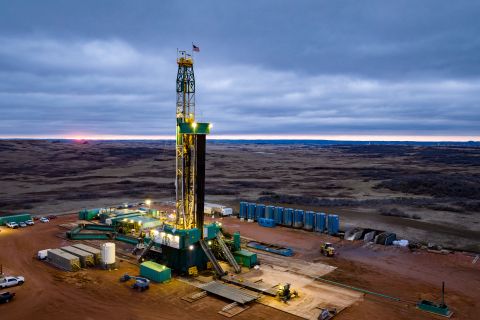
Natural gas liquids (NGL) prices started 2012 in a bit of a tailspin and this situation, for the most part, deteriorated further as the year progressed.
The second half of 2012 experienced a pick-up in prices, but much of this was a result of prices bottomed out in June before coming back to a more normalized level.
While Conway prices were more depressed than Mont Belvieu for much of 2012, this situation reversed course in the final weeks of the year as pipelines bringing additional supplies from the Eagle Ford and Permian basin were brought online.
Although there are concerns that ethane crackers are not being brought online at a quick pace, it is important to note that the ethane market should experience a pick-up in 2013 as it benefits from a full-year of steady cracking capacity.
The NGL that suffered the most in 2012 was undoubtedly ethane, which experienced decreases as demand was lessened for much of the year due to several important ethane crackers undergoing turnarounds and expansions in the Gulf Coast.
In addition, propane became more attractive to crackers as a feedstock as ethylene co-product prices rose and propane prices dropped as a result of a warm winter that drastically affected heating demand.
Ethane prices began the year at an average of 65¢ per gallon (/gal) at Mont Belvieu in January with an average margin of 43¢/gal in the month. By the end of the year, this average price had decreased 65% to 23¢/gal in December while the margin took a 98% nosedive to 1¢/gal.
As bad as these figures were, Conway prices and margins were much worse, as they spent much of the year in a negative state that caused ethane to be rejected throughout the Midcontinent and Rockies for much of the second half of 2012.
While the average price of E-P mix, which is how the product is traded at Conway, fell from an average of 29¢/gal in January to 18¢/gal in December, it fell as low as an average of 7¢/gal in June. Conway E-P mix produced a theoretically positive average margin of 6¢/gal in January before closing the year with an average margin of negative 4¢/gal in December.
It is likely that ethane prices and margins will continue to struggle for at least the beginning of 2013. According to Peter Fasullo, principal at En*Vantage Inc., the market needs to continue to reject ethane until March at the earliest, while the ethylene industry operates at 95% of nameplate capacity to bring itself back into balance.
Although propane prices and margins remained profitable at both Conway and Mont Belvieu, they also lost considerable value throughout 2012. However, the outlook for 2013 is more positive for propane.
It is unlikely that the U.S. will face another winter like the one of 2012, which the U.S. National Climatic Data Center determined was the fourth-warmest winter in the more than 100 years it has kept track of temperatures.
Normalized winter temperatures should to balance propane inventory levels as export capacity will be increased once Enterprise Products Partners completes expansions to its export unit on the Houston Ship Channel. These expansions are expected to increase capacity by 3.5 million barrels (bbl.) per day to approximately 7.5 million bbl. per day.
Improvements in demand levels would certainly help the market improve from a rough 2012, which saw Mont Belvieu prices tumble 39% from an average price of $1.30/gal in January and an average margin of 99¢/gal to an average price 80¢/gal in December with an average margin of 49¢/gal. The Conway price took less of a hit as the price increased in the fourth quarter as the weather was colder in that section of the country. The price declined 29% from an average of $1.02/gal in January with a margin of 71¢/gal to an average price of 73¢/gal in December with an average margin of 42¢/gal.
Heavy NGL prices also dropped in value, but at a much slower rate compared to light NGLs. Though NGL and crude prices have been diverging somewhat from their historically close relationship in recent years, the two products still retain a largely symbiotic relationship. This relationship helped heavy NGLs, which are used in the crude refining process; maintain strong price levels throughout the year as crude prices were largely stable.
Although both Brent and WTI crude prices peaked early in 2012, they hit the $80 per barrel (/bbl.) threshold in the middle of the year before increasing their value to approximately $90/bbl. for much of the second-half of the year.
Pipeline Projects Expected To Dominate Construction In 2013
Looking back at energy prices, 2012 was a pretty rough year, but the future for fossil fuels remains strong in the coming years. The fact is North America is awash in natural gas thanks to the huge resources being unlocked from shale plays.
The infrastructure story of 2012 was the amount of rail projects taking place to meet demand out of the Bakken shale. “Rail may cost more per barrel, but for producers seeking Brent pricing, it’s the only game in town,” according to Tudor, Pickering, Holt & Co.’s director of midstream research Bradley Olsen.
However, expect a major push for more pipeline projects in 2013, especially in the Northeast and Southeast markets as they increase their use of natural gas as a power- generation fuel.
This energy source is expected to grow to surpass coal as the second-most used energy source in North America due to its increasingly lower price along with its lower greenhouse gas emission rates.
“We’ll see a continued focus on utilities in 2013, particularly the transmission and natural gas distribution side, improving their infrastructure by adding new pipelines, upgrading regulating stations and increasing capacity in some cases,” Joan Fontaine, vice president at Fuss & O’Neill, a civil and environmental consulting engineering firm, told Midstream Monitor.
“A lot of what is stimulating these projects is the demand for natural gas, which has tremendous economic and environmental benefits compared to alternative sources of energy available today,” she continued.
This demand will continue to grow as companies find new ways to use natural gas for economic and environmental purposes, Mike Nicoloro, a senior vice president at Fuss & O’Neill, told Midstream Monitor.
“There are all kinds of opportunities out there for people willing to think outside of the traditional usage of fuels,” he said. In the past year, Fuss & O’Neill has helped companies save money and retain jobs through the increased use of natural gas.
Fontaine noted that the company worked with Gorham Paper and Tissue to switch from using fuel oil to using natural gas to power their paper mill in Gorham, New Hampshire. This move enabled the company to bring 230 people back to work that had been furloughed while saving more than $250,000 per week in fuels costs when running at full production.
Nicoloro stated that Fuss & O’Neill is currently working with a company in Vermont to convert a calcium carbonate plant from fuel oil to liquefied natural gas (LNG) that will save the company $10,000 per day. In addition, this conversion will help bring new business to the operation as it will include a fuel dispenser to provide LNG for trucks. Such projects are enabling companies that have been operating in the red to return to profitability. “Natural gas isn’t only going to create jobs, it’s going to save jobs,” he said.
Natural gas won’t just take market share from other fossil fuels, but will also extend the timeframe for renewables and other alternative fuels to become economically viable. Over the past few years, natural gas has been called a bridge fuel to these other forms of energy, such as wind and solar power, according to Fontaine.
“Natural gas is the green bridge to renewables, especially given the supplies available in this country. I think it’s still characterized as a bridge fuel, but that bridge has only become longer. The likelihood of cleaner alternative-fuel sources being ready to take on a larger role when it comes to the country’s energy mix in the next few years is very small,” she said.
Nicoloro added that natural gas will continue to outpace the use of renewable energy sources for at least the next 15 years. “I believe in renewables, but they’re an insurance policy. What’s giving a lot of renewable projects their life are the government subsidies. Without those these projects don’t make economic sense. We’ve coined the phrase that a project must be green squared, meaning it must be green from a financial perspective and green from an environmental point of view. If it doesn’t meet these criteria, chances are it’s not going to work. It has to be able to stand on its own two feet.”


Contact the author, Frank Nieto, at fnieto@hartenergy.com
Recommended Reading
Smart Tech Moves to the Hazardous Frontlines of Drilling
2024-10-08 - In the quest for efficiency and safety, companies such as Caterpillar are harnessing smart technology on drilling rigs to create a suite of technology that can interface old and new equipment.
E&P Highlights: Sept. 23, 2024
2024-09-23 - Here's a roundup of the latest E&P headlines, including Turkey receiving its first floating LNG platform and a partnership between SLB and Aramco.
Navigating the Crossroads: Oil, Gas Industry Reimagines its Role in Tech Age
2024-10-28 - The oil and gas industry has both a need and an opportunity to embrace the digital transformation while engaging the next generation of its workforce.
US Drillers Cut Oil, Gas Rigs for Fifth Week in Six, Baker Hughes Says
2024-09-20 - U.S. energy firms this week resumed cutting the number of oil and natural gas rigs after adding rigs last week.
E&P Highlights: Oct. 28, 2024
2024-10-28 - Here’s a roundup of the latest E&P headlines, including a new field coming onstream and an oilfield service provider unveiling new technology.
Comments
Add new comment
This conversation is moderated according to Hart Energy community rules. Please read the rules before joining the discussion. If you’re experiencing any technical problems, please contact our customer care team.




